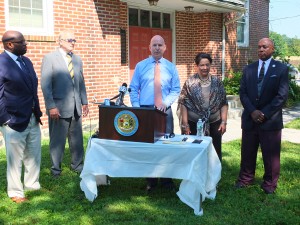More checks of prescription database, reviews of deaths, medical treatment of addiction and expanded police use of overdose drug proposed.
Building on Delaware’s efforts in recent years to combat prescription painkiller and heroin abuse, a plan released Thursday recommends that regulations governing prescription dispensing become more stringent, that deaths from opiates and heroin be reviewed to learn how they could have been prevented, that medical treatment of addiction be expanded and that more police be equipped with a drug that can counteract the effects on an overdose in an emergency, Attorney General Matt Denn was joined by Secretary of Health and Social Rita Landgraf, New Castle County Police Chief Col. Elmer Setting, Delaware Fraternal Order of Police president Fred Calhoun and atTAcK Addiction board members David Humes, Don Keister, and Rebecca King, to release the plan and begin discussions with those involved in the fight against opiate and heroin abuse.
“We are here today because, notwithstanding some extraordinary effort and hard work by many people in our state, far too many Delawareans are dying from prescription drug and heroin overdoses,” said Attorney General Denn. “The catalysts behind many of the state’s efforts in the last several years to deal with substance use disorder have been the family members of Delawareans who suffered from drug overdoses – some of whom did not survive. We owe it to them, and other families who have lost loved ones, to redouble our efforts.”
“When doctors prescribe opiates as pain medication, it is like giving patients a loaded gun that must be handled properly so that death by the disease of addiction does not occur,” Don Keister said, noting a need for doctors to limit the number of prescribed pills and also inquire into a patient’s family history and situation for signs of potential misuse.
“Sadly we are fighting a disease of epidemic proportion, and this disease is destroying, and is taking lives,” Secretary Landgraf said in talking about recovery options. “We know that treatment works and that recovery is possible.”
The plan addresses in four areas that should positively impact the prevalence of prescription opioid and heroin abuse:
• Strengthening the regulations that govern the amount of care that health care providers must exercise in prescribing opiate drugs. The state Controlled Substance Advisory Committee has drafted regulations to govern prescription by doctors and the plan includes ideas – already submitted in comment form – to make those regulations even strong before they are finalized.
• Conducting routine state reviews of deaths caused by prescription opiate and/or heroin overdoses to determine what could have been done differently, similar to reviews currently done in child death cases. Such a process would need to be created by the action of the legislature in 2016.
• Maximizing the responsible use of medically assisted treatment of substance abuse disorder. A group of medical professionals and advocates would convene to discuss best practices in the use of medications like Suboxone, methadone and naltrexone, which some doctors have advocated for wider use of to treat addiction.
• Encouraging our state’s law enforcement community to expand the number of officers who carry naxolene, a drug that is effective in reversing the effect of heroin overdoses. This drug has been successfully employed in nine cases by New Castle County Police (7), Middletown Police (1) and Ocean View (1) police to avert a potentially fatal overdose.
“The folks that are addicted to heroin aren’t necessarily criminals, they are certainly victims,” Col. Setting said. “These people need help and I am so glad that I am not the only person saying it any longer. This is not just a police problem.”
Speaking about police support for equipping officers with addiction-countering medication, FOP president Calhoun said “None of my officers want to be standing in the doorway when a family member or child walks up from the sidewalk, looking into their eyes, knowing that the next thing you’re going to tell them will impact them for the rest of their lives.”
Deaths from prescription opioid abuse and from illegal heroin remain as problems in Delaware. The Prescription Drug Monitoring Program, begun in 2012, is a significant advancement that should become more effective over time with improved utilization. Using various statistical measures from 2009 and 2010, the Prescription Drug Advisory Committee found in 2013 that Delaware had the nation’s ninth highest drug overdose rate, had a significantly higher percentage of its residents engaging in non-medical use of prescription opioids than the national average, and had the nation’s fifth highest overall rate for opioid sales. Regarding illegal heroin use, the number of deaths in Delaware from heroin overdoses increased from 8 deaths in 2009 to 23 in 2013.

